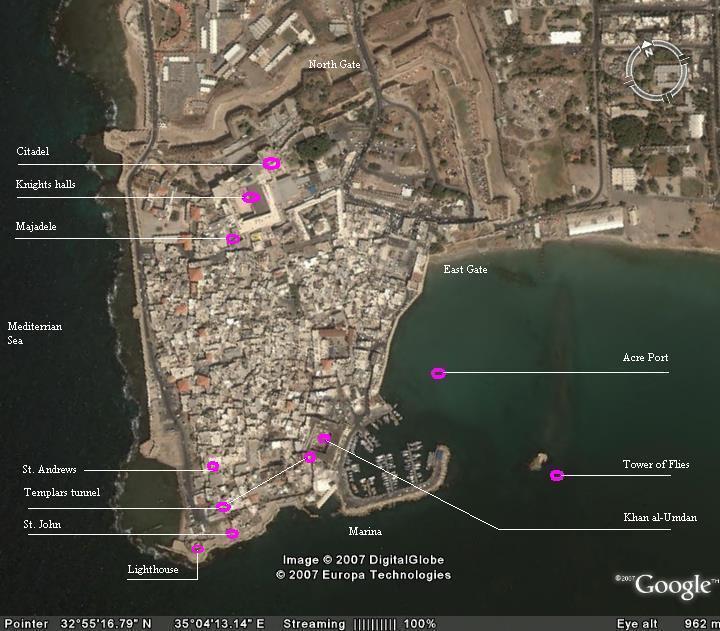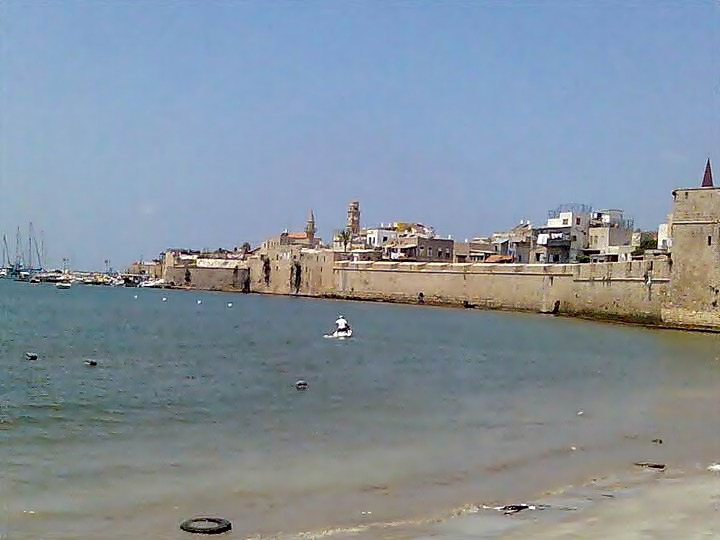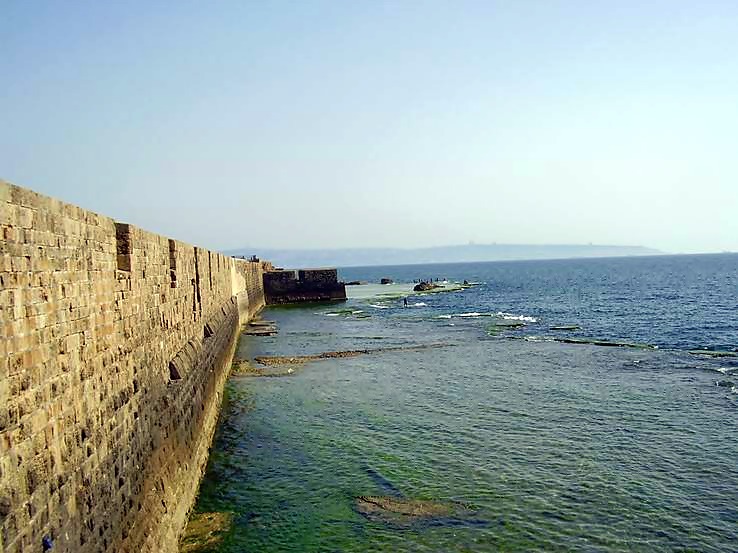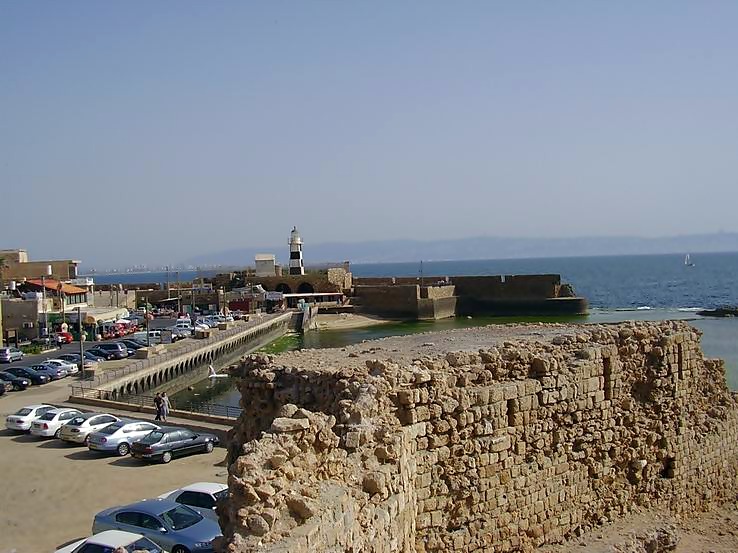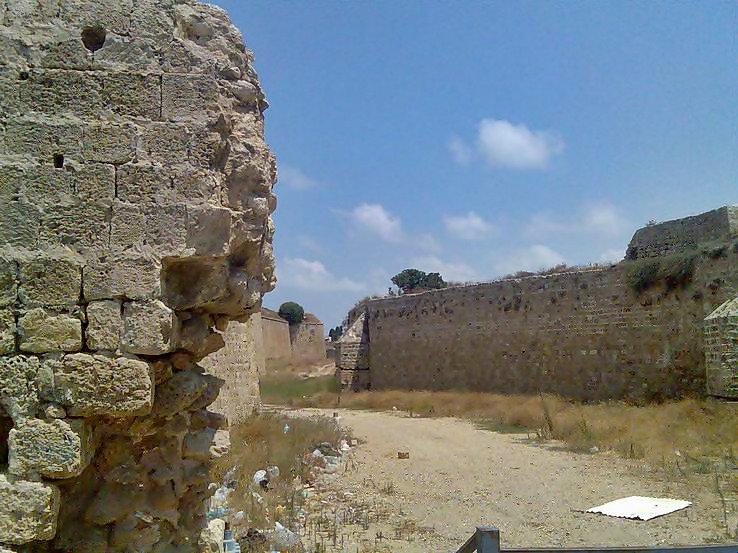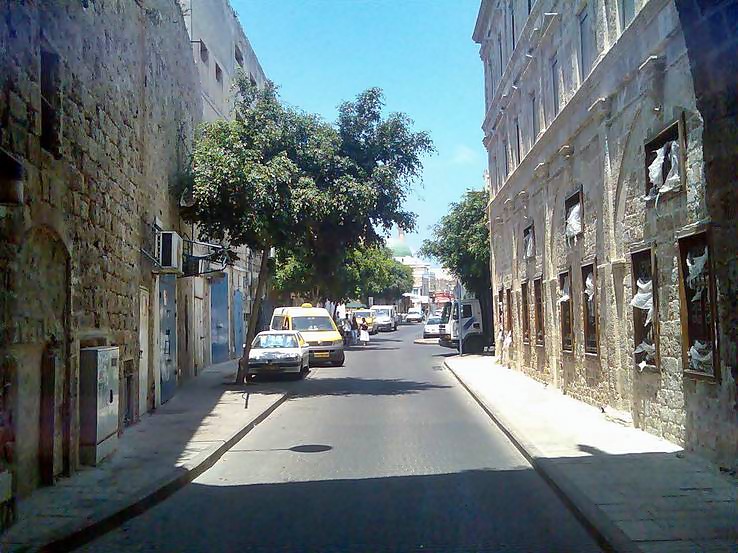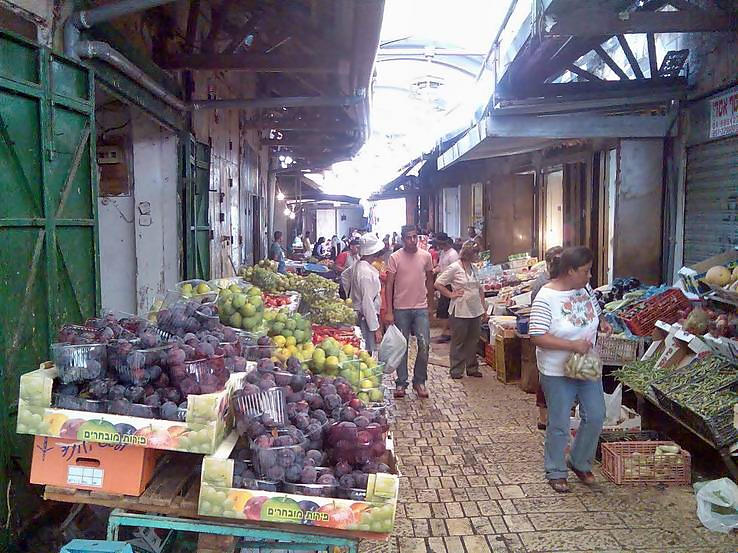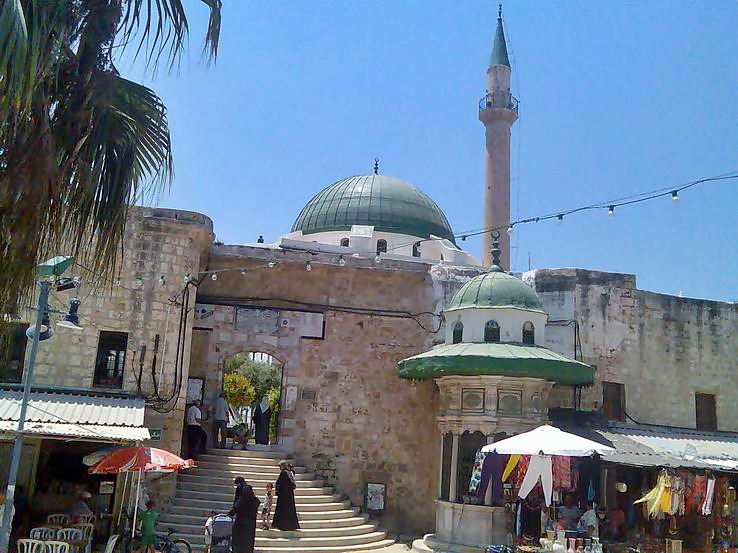The old city of Acre (Akko) is a large walled city on the shores of the bay of Haifa. As the largest natural port in the Galilee and Israel, it has a long history of conquests and ruling empires. It was one of the main Crusaders’ fortifications and ports.
Home > Sites > Acre – Overview
Contents:
Background
Location
History
Photos
* Aerial Views
* General Views
Visit
Biblical Refs
Historical Refs
Other Refs
Etymology
Acre sites
Background:
The Old city of Acre is one of the fascinating old cities in Israel. It is a UNESCO World Heritage Site. Rich in history, spanning from the Greek periods, this ancient city has fascinating points of interest as well as a charming location along the Sea. Acre is well known as one of the main Crusaders cities.
Location:
Acre is located at the North of Israel, on the shores of the bay of Haifa. The Old City is located on the south eastern side of the city, and is surrounded entirely by a wall.
An aerial map of the old city of Acre is shown below, indicating the major points of interest.
History of the place:
- Tel Akko
Acre/Akko was inhabited from the Bronze age to the Hellenistic period in a tell (mound) east of the old city, on the north bank of the Na’aman river. See a detailed review of Tel Akko – the biblical site of Akko.
Tel Akko history highlights:
- 16th Century BC Mentioned as “Aak” of the tribute-lists of Egyptian Pharaoh Thutmose III
- 14th Century BC Mentioned in the Amarna letters, a 14th century BC Egyptian archive of clay tablets
- 8-6th Century BC Major port for the Phoenicians (from Sidon); city named “Ace”
- 6Th -4th Century BC Persians conquer the city and expand it to the west
- 332 BC Greek rule starts: Alexander the Great takes control
- 230 BC Ptolmey II from Egypt renames city to Ptolemais, and makes it a major Greek city
- 200 BC Switched to Seleucids of Syria
- … From this time on the city moves west, away from the Tell (Mound)
- Current location of the city
The Tel was abandoned and moved to the west.
The Romans built a breakwater and expanded the harbor at the present location of the harbor.
During the early Arab period the old city was built at the present location, and was later fortified by the Crusaders. The following list shows a long chain of conquests and ruling empires over thousands of years.
Highlights:
On the new location west of the Tel:
- 150 BC Jonathan, the Hasmonite King, conquers the city
- 63 BC Pompey takes all Syria cities under Roman control, including Acco
- 48 BC Julius Caesar visits the city
- 54 AD Roman Colonia established by Claudius (Colonia Claudia Felix Ptolemais)
- 59 AD Paul of Tarsus stops at the city
- 636 AD Arabs conquer the city; name it Akka
- 1104 AD Crusaders conquer the city (they bypassed it 5 years earlier); fortify the city and expand the port
- 1187 AD Saladin takes the city after capturing Jerusalem; Christians are evacuated
- 1188 AD Crusaders try to retake Acre but fail
- 1191 AD Richard the Lion Heart retakes the city on the 3rd Crusade
- Acco becomes the capital of the remnant of the Kingdom of Jerusalem
- 1229 AD Controlled by the Hospitallers Knights
- 1291 AD After siege, Mamelukes capture the city; they destroy it completely;
- …the city remains a small village 1517AD Ottomans take the city; city falls into total decay
- 1746-1775 Daher el-Omar captures the city, refortifies it
- end of 18th Century Jezzer Pasha improves and fortifies the city
- 1799 AD Napoleon’s failed siege on the City against the Ottomans
- 1831 AD General Ibrahim Pasha, General of Egypt, conquers and destroys the city
- 1840 AD Bombarded by British, Austrian and French; city returns to Turks
- 1867-1892 BahaUllah, founder of Bahai faith, is exiled to Acre; he lives and dies in the city
- 1918 AD British forces take the city from the Turks (WW1)
- 4.05.1947 Jewish Irgun forces force in the Central jail and release prisoners
- 17.5.1948 City Captured by Israeli Forces
Photos:
Aerial view:
An aerial view, captured by a drone 100m above the north east corner of the old city, is seen in the picture. The old port of Acre is on the far left side. Behind, in the background, is the bay of Haifa and Mount Carmel. In the center of the view if the new Acre hostel. On both left and right margins are the city walls and moat, with the entrance bridge located above the moat on the right side.
Click on the photos to view in higher resolution…
![]() Fly over the site and view its surroundings with the following YouTube video:
Fly over the site and view its surroundings with the following YouTube video:
General Views:
A view of the old city from the eastern gate side is shown in the following photo. The ancient harbor, still in use today, is seen on the left side.
The western side of the old city stretches along the shore, as can be seen in the following photo. The wall can be seen, with a tower at the far end. You can walk along the wall around the whole city. In the background – Mount Carmel and the port city of Haifa.
A closer look on the western side: the lighthouse at the edge of the city. In the background – Mount Carmel and the bay of Haifa. On the left side – the houses of the Arabs that live in the old city. It is also the western side of the Templars tunnel.
On the Northern and eastern side, which is connected to the land, the Crusaders, and later the Mamlukes and Turks, fortified the city with a dry moat, thick walls and three outpost towers. These massive fortifications (near the eastern gate) were so strong that Napoleon failed to conquer the city after a 2 months siege (1799 AD).
A view from the east gate into the old city and towards the market.
In the old city – a colorful and busy fruit, fish and meat market. You can stroll along these narrow alleys and head towards the marina.
The large El-Jazar Mosque in the center of the old city, adjacent to the market, dominates the skyline. The mosque was completed in 1781, and is the largest mosque in Israel after Jerusalem. In its grounds, the graves of its builder, Jezzer Pasha. Under the yard there are large cisterns that contained the water that flowed from the Aqueduct of Acre.
In the old city are 4 Churches and 2 Monasteries, which serve the different Christian sects. Most of them are built over Crusaders time churches, such as St. John on the south side which was built over 12thC St. Andrews.
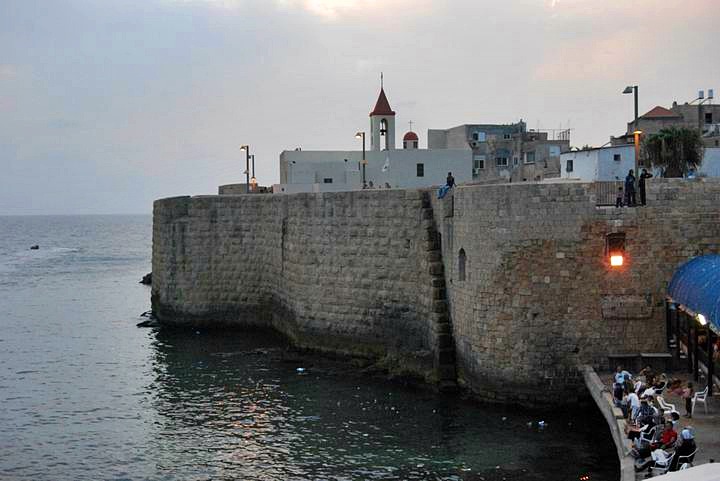
Visit at the site:
It is best to park the car near the eastern gate (free parking). Then, walk thru the gate along the main road to the El-Jazar mosque. You can stop and have a delicious Arabic meal – one of the best Hummus in Israel is served at the tiny shops.
Across the entrance to the Mosque, take a one hour tour under the city through the Crusaders’ quarters that were unearthed in recent years. The tour passes thru the complex of the Hospitaller Knights’ Halls which were part of the northern walls that protected the city. The tour will take you out to the Turkish Hamam (hot bath). From there, go to the market towards the Marina. After a visit there you can return back to the car.
Additional place to visit is in the western side, near the lighthouse. You can also walk along the walls that connect the lighthouse to the Marina.
Biblical References:
(a) Old Testament References
See the review of Tel of Akko, the biblical site of acre.
(b) The Acts of the Apostles (21, 7-8)
Luke tells about Paul of Tarsus, traveling aboard a ship, stopped at Ptolemais ( 59 AD):
“And when we had finished our course from Tyre, we came to Ptolemais, and saluted the brethren, and abode with them one day. And the next day we that were of Paul’s company departed, and came unto Caesarea:…”
Historical References:
Josephus Flavius (War of the Jews)
The historian Josephus Flavius (1st century AD) has numerous references on Ptolemais (Akko), a major city at that time (and throughout history). A few examples are detailed below.
(a) Book 1, Chapter 20, 3:
A passage about Herod riding with Augustus, who was chasing Antony which fled to Egypt:
“After this Caesar went for Egypt through Syria, when Herod received him with royal and rich entertainments; and then did he first of all ride along with Caesar, as he was reviewing his army about Ptolemais, and feasted him with all his friends, and then distributed among the rest of the army what was necessary to feast them withal.”
(b) Book 3 , Chapter 2, 4:
Josephus tells about the beginning of the war against the Jews (67AD) when Vespasian, the commander of the Roman forces that crushed the rebellion, entered to Israel through Acco, where he accepted petitions from different cities, such as Sepphoris:
“And now Vespasian took along with him his army from Antioch … where he found king Agrippa, with all his forces, waiting for his coming, and marched to Ptolemais. At this city also the inhabitants of Sepphoris of Galilee met him, who were for peace with the Romans.”.
Other References:
- Old Acre Development company
Etymology (behind the name):
Acre switched names many times since different empires ruled it:
- Ace – Phoenician name
- Akko – Biblical name
- Ptolemais – Greek name, meaning “warlike”. Based on the name of Alexander’s general who ruled Egypt after his death. The city was first renamed to “Antiochia Ptolemais” and then by Ptolemy II Philadelphus (238-246 BC) to “Ptolemais” .
- Colonia Claudia Felix Ptolemais – named by the Romans after a colony of veterans were settled by Claudius (54AD)
- Akka – named by the Arabs (9th Century)
- St. Jean (John) d’Acre – named by the Crusaders
Acre sites:
BibleWalks featured sites in Acre:
- Inside the old city:
Khan Al-Umdan , Hummus in Acre, Acre Port,
Templars tunnel, Knights halls, Acre Citadel,
St. John’s Church, St. Andrews, St. George ,
El Majedele Mosque, Lighthouse
- Outside the old city:
Acre Aqueduct , Tell Akko, Bahai sites, Lost cities
![]() Check also our Acre sites Gallery.
Check also our Acre sites Gallery.
BibleWalks.com – bringing the Bible Alive!
Navigation bar (follows the sites in Acre):
<<<All Sites>>> —-next Acre site –>>> Tell Akko
This page was last updated on May 13, 2024 (text updates)
Sponsored links:
